1
A good supply of water was critical to the operation of the Creamery. The original source was a well under the warehouse. Water from the well overflowed into a cement tank in the nearby feed mill and was piped into the Creamery.2
Cutting ice for the icehouse (1)20th century
Mattatall Lake near Tatamagouche
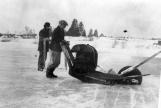 Credits:
Credits:North Shore Archives
Willis Cock
3
In order to ensure cold water large blocks of ice were cut from local lakes and ponds to be used at the Creamery. Willis Bonnyman recalls that ice was obtained from local Silica Pond, Roode's Pond and Mattatalls Lake. Here George Cock uses a motorized cutter to slice into the ice. Willis Cock, his son, explains, "The machine that cut the ice into 20 inch squares was made by my father George Cock, and a neighbour, Jack Ross . . . the engine was from an old 4 cylinder Chev . . . a pulley was attached directly to the flywheel of the engine. The arbor was the same as that used for cutting firewood . . . a flatbelt connected the engine to the arbor and saw. The sled was made with a depth regulator so that you could cut only to the desired depth - this was about three quarters of the thickness of the ice. The sled also had a marking device to indicate where the next ice cut should be . . ."4
Cutting ice for the icehouse on local lake20th century
Mattatall Lake near Tatamagouche
 Credits:
Credits:North Shore Archives
5
When cutting the ice, several parallel cuts were made and then the ice was cut again across these first cuts. This created several blocks partly cut into 20 inch squares. A cake was then cut out of the end of the row. To finish cutting cakes, a cross-saw was used. A two man saw was used and once the cuts were made at each end of the line a cake was removed with a modified crowbar which would break the row free. The cake could be floated close to the loading area and the rest of the row separated. A man then pulled the cakes out of the water.6
Men loading ice for the Creamery20th Century
Mattatall Lake near Tatamagouche
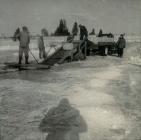 Credits:
Credits:North Shore Archives
Willis Cock
7
This wooden platform was lined along the bottom with iron spikes which pressed into the ice making a non-slip surface for the crew to work on. After being cut, the ice blocks were angled to the base of the ramp using a long-handled hook with a spike. Two men then lifted the block to a raised platform where two more men hoisted it on to the truck. Two men were needed as the cakes of ice could weigh over 170 pounds.8
Loading ice into the icehouse20th century
The Tatamagouche Creamery, Creamery Road, Tatamagouche, Nova Scotia, Canada
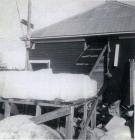 Credits:
Credits:North Shore Archives
Willis Cock
9
Once cut, the ice cakes were hauled to the the icehouse at the Creamery where it was stored for year round use. Ice could be picked up at the Creamery for home use, but most was used by Creamery. In the early days unloading ice to the icehouse meant shifting the heavy cakes to a wooden platform and then edging them on to a belt that carried the ice inside.10
Cleaning the icehouse at the Creamery20th century
The Tatamagouche Creamery, Creamery Road, Tatamagouche, Nova Scotia, Canada
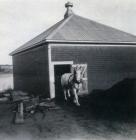 Credits:
Credits:North Shore Archives
11
After the ice had been used up, the remaining mess of wet saw-dust and hay which had helped to insulate the ice and keep it from melting had to be removed from the icehouse - a horse helped in this mucky process.12
Loading ice in icehouse became more efficient20th century
The Tatamagouche Creamery, Creamery Road, Tatamagouche, Nova Scotia, Canada
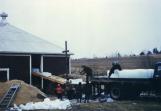 Credits:
Credits:North Shore Archives
13
A more efficent process for moving ice from the truck to the icehouse was using an automatic conveyor belt. Eased from the truck, the ice went smoothly inside where it was efficiently stacked to fit as much ice as possible into the icehouse. Ice had to last a long time, so it was thickly covered with saw-dust and hay.14
Inside the ice house20th century
The Tatamagouche Creamery, Creamery Road, Tatamagouche, Nova Scotia, Canada
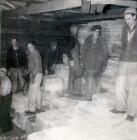 Credits:
Credits:North Shore Archives
Willis Cock